Gold Nanoparticles - Properties - Gold Nanorods' SPR vs. Aspect Ratio as a function of Diameter
We have used an experimental approach to determine the effect of gold nanorod diameter and length on the peak longitudinal Surface Plasmon Resonance.
After manufacturing over one thousand lots of gold nanorods from diameters as small as 6nm to lengths as long as 250nm, we have grouped our resultant data to some interesting results.
Background [1]
Gold nanorods (AuNRs) with diameters <25 nm typically show longitudinal dipole Surface Plasmon Resonance Wavelengths (SPR λ) that scale linearly with the aspect ratio almost independently of the actual diameter, thereby emphasizing the effect of the AuNR length. [2] This fact is routinely used in characterizing AuNRs based on their optical extinction spectra and agrees well with calculations using the quasi-static, i.e., dipole, approximation. [3, 4] On the other hand, the similarity to radio antennas has sparked considerable interest in using plasmonic AuNRs to concentrate and localize optical radiation thereby beating the diffraction limit of conventional optics. For such device applications, the AuNR length has to approach about half the wavelength of the light in order to act as a resonant antenna. [5, 6] For AuNRs with diameters of ∼80 nm but high aspect ratios (>10), the length remains the more important parameter. [7, 8] As the overall size increases in diameter > 25nm, however, the longitudinal dipole SPR λ starts to depend sensitively on the width as well. [9, 10] Phase retardation and dynamic depolarization effects [11, 12] become important, and a simple relationship between SPR λ and the aspect ratio therefore no longer applies. Numerical simulations accounting for the absolute dimensions of the AuNRs have predicted this departure from the quasi-static scaling of the longitudinal dipole SPR λ with aspect ratio. [13, 14]
Here we show this experimentally and in fact, according to our results, at diameters >50nm, the SPR max is dependent more on the diameter than on the length. Figures and Tables 1-4 show the resultant plots of Aspect Ratio vs. SPR for diameters 10nm, 25nm, 40nm, and 50nm respectively. Figure and Table 5 shows a plot of both slope and y-intercept for these curves as a function of diameter. This graph shows the dependence where at 50nm, the slope has decreased to a point where it is equal to the y-intercept showing the heightened dependence on diameter over aspect ratio.
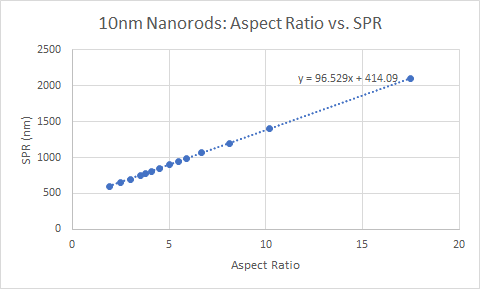
| Diameter (nm) | Length (nm) | Aspect Ratio (Length/Diameter) | Longitudinal SPR (nm) | Calculated SPR from AR | Calculated AR from SPR |
| (SPR-418)/96 | (AR*96)+418 | ||||
| 10 | 19 | 1.9 | 600 | 1.9 | 600 |
| 10 | 24 | 2.5 | 650 | 2.4 | 658 |
| 10 | 29 | 3 | 700 | 2.9 | 706 |
| 10 | 35 | 3.5 | 750 | 3.5 | 754 |
| 10 | 38 | 3.8 | 780 | 3.8 | 783 |
| 10 | 41 | 4.1 | 808 | 4.1 | 812 |
| 10 | 45 | 4.5 | 850 | 4.5 | 850 |
| 10 | 50 | 5 | 900 | 5 | 898 |
| 10 | 55 | 5.5 | 950 | 5.5 | 946 |
| 10 | 59 | 5.9 | 980 | 5.9 | 984 |
| 10 | 67 | 6.7 | 1064 | 6.7 | 1061 |
| 10 | 81 | 8.1 | 1200 | 8.1 | 1196 |
| 10 | 102 | 10.2 | 1400 | 10.2 | 1397 |
| 10 | 175 | 17.5 | 2100 | 17.5 | 2098 |
Figure and Table 1 showing Aspect Ratio vs. SPR for 10nm diameter gold nanorods of increasing length.
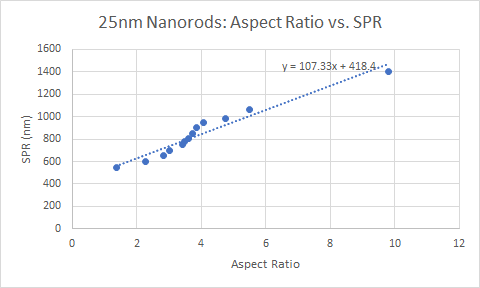
| Diameter (nm) | Length (nm) | Aspect Ratio (Length/Diameter) | Longitudinal SPR (nm) | Calculated SPR from AR | Calculated AR from SPR |
| (SPR-418.4)/107.3 | (AR*107.3)+418.4 | ||||
| 25 | 34 | 1.36 | 550 | 1.23 | 564 |
| 25 | 57 | 2.28 | 600 | 1.69 | 663 |
| 25 | 71 | 2.84 | 650 | 2.16 | 723 |
| 25 | 75 | 3 | 700 | 2.62 | 740 |
| 25 | 85 | 3.4 | 750 | 3.09 | 783 |
| 25 | 87 | 3.48 | 780 | 3.37 | 792 |
| 25 | 90 | 3.6 | 808 | 3.63 | 805 |
| 25 | 93 | 3.72 | 850 | 4.02 | 818 |
| 25 | 96 | 3.84 | 900 | 4.49 | 830 |
| 25 | 102 | 4.08 | 950 | 4.95 | 856 |
| 25 | 119 | 4.76 | 980 | 5.23 | 929 |
| 25 | 137 | 5.48 | 1064 | 6.02 | 1006 |
| 25 | 245 | 9.8 | 1400 | 9.15 | 1470 |
Figure and Table 2 showing Aspect Ratio vs. SPR for 25nm diameter gold nanorods of increasing length
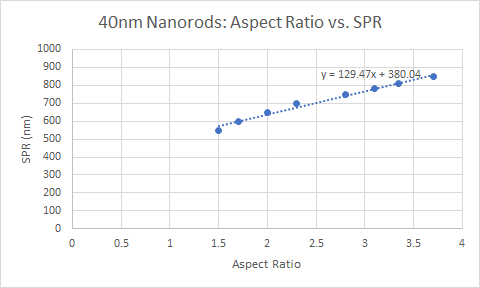
| Diameter (nm) | Length (nm) | Aspect Ratio (Length/Diameter) | Longitudinal SPR (nm) | Calculated SPR from AR | Calculated AR from SPR |
| (SPR-380)/129.5 | (AR*129.5)+380 | ||||
| 40 | 60 | 1.5 | 550 | 1.31 | 574 |
| 40 | 68 | 1.7 | 600 | 1.7 | 600 |
| 40 | 80 | 2 | 650 | 2.08 | 639 |
| 40 | 92 | 2.3 | 700 | 2.47 | 678 |
| 40 | 112 | 2.8 | 750 | 2.86 | 743 |
| 40 | 124 | 3.1 | 780 | 3.09 | 781 |
| 40 | 134 | 3.35 | 808 | 3.31 | 814 |
| 40 | 148 | 3.7 | 850 | 3.63 | 859 |
Figure and Table 3 showing Aspect Ratio vs. SPR for 40nm diameter gold nanorods of increasing length
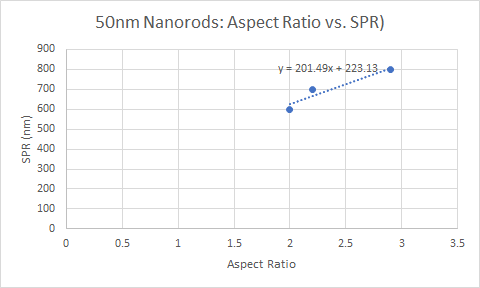
| Diameter (nm) | Length (nm) | Aspect Ratio (Length/Diameter) | Longitudinal SPR (nm) | Calculated SPR from AR | Calculated AR from SPR |
| (SPR-223)/201.5 | (AR*201.5)+223 | ||||
| 50 | 100 | 2 | 600 | 1.87 | 626 |
| 50 | 110 | 2.2 | 700 | 2.37 | 666 |
| 50 | 145 | 2.9 | 800 | 2.86 | 807 |
Figure and Table 4 showing Aspect Ratio vs. SPR for 50nm diameter gold nanorods of increasing length
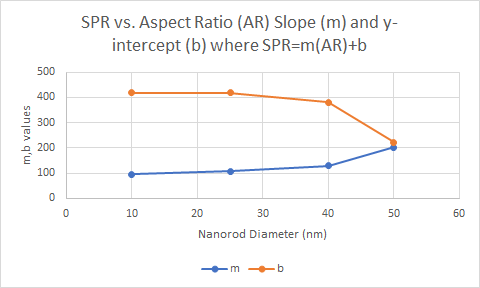
| Diameter (nm) | m | b |
| 10 | 96 | 418 |
| 25 | 107.3 | 418 |
| 40 | 129.5 | 380 |
| 50 | 201.5 | 223 |
Figure and Table 5 plotting slope and y-intercept values for each diameter shown in the previous plots.
References
[1] Liane S. Slaughter, Wei-Shun Chang, Pattanawit Swanglap, Alexei Tcherniak, Bishnu P. Khanal, Eugene R. Zubarev, and Stephan Link, Single-Particle Spectroscopy of Gold Nanorods beyond the Quasi-Static Limit: Varying the Width at Constant Aspect Ratio, J. Phys. Chem. C 2010, 114, 4934–4938
[2] Miller, M. M.; Lazarides, A. A. Sensitivity of Metal Nanoparticle Surface Plasmon Resonance to the Dielectric Environment. J. Phys. Chem. B 2005, 109, 21556–21565.
[3] Murphy, C. J.; Sau, T. K.; Gole, A. M.; Orendorff, C. J.; Gao, J.; Gou, L.; Hunyadi, S. E.; Li, T. Anisotropic Metal Nanoparticles: Synthesis, Assembly, and Optical Applications. J. Phys. Chem. B 2005, 109, 13857– 13870.
[4] Nikoobakht, B.; El-Sayed, M. A. Preparation and Growth Mech- anism of Gold Nanorods Using Seed-Mediated Growth Method. Chem. Mater. 2003, 15, 1957–1962.
[5] Novotny, L. Effective Wavelength Scaling for Optical Antennas. Phys. ReV. Lett. 2007, 98, 266802/266801–266802/266804.
[6] Bryant, G. W.; Garcia de Abajo, F. J.; Aizpurua, J. Mapping the Plasmon Resonances of Metallic Nanoantennas. Nano Lett. 2008, 8, 631– 636.
[7] Aizpurua, J.; Bryant, G. W.; Richter, L. J.; Garcia de Abajo, F. J.; Kelley, B. K.; Mallouk, T. Optical Properties of Coupled Metallic Nanorods for Field-Enhanced Spectroscopy. Phys. ReV. B 2005, 71, 235420–235413.
[8] Gomez-Medina, R.; Yamamoto, N.; Nakano, M.; Garcia de Abajo, F. J. Mapping Plasmons in Nanoantennas Via Cathodoluminescence. New J. Phys. 2008, 105009.
[9] Myroshnychenko, V.; Rodriguez-Fernandez, J.; Pastoriza-Santos, I.; Funston, A. M.; Novo, C.; Mulvaney, P.; Liz-Marzan, L. M.; Garcia de Abajo, F. J. Modelling the Optical Response of Gold Nanoparticles. Chem. Soc. ReV. 2008, 37, 1792–1805.
[10] Khlebtsov, B. N.; Khlebtsov, N. G. Multipole Plasmons in Metal Nanorods: Scaling Properties and Dependence on Particle Size, Shape, Orientation, and Dielectric Environment. J. Phys. Chem. C 2007, 111, 11516–11527.
[11] Kuwata, H.; Tamaru, H.; Esumi, K.; Miyano, K. Resonant Light Scattering from Metal Nanoparticles: Practical Analysis Beyond Rayleigh Approximation. Appl. Phys. Lett. 2003, 83, 4625–4627.
[12] Meier, M.; Wokaun, A. Enhanced Fields on Large Metal Paricles: Dynamic Depolarization. Opt. Lett. 1983, 8, 581–583.
[13] Encina, E. R.; Coronado, E. A. Resonance Conditions for Multipole Plasmon Excitations in Noble Metal Nanorods. J. Phys. Chem. C 2007, 111, 16796–16801.
[14] Pelton, M.; Aizpurua, J.; Bryant, G. Metal-Nanoparticle Plasmonics. Laser Photonics ReV. 2008, 2, 136–159.
